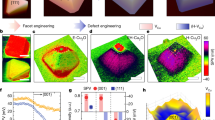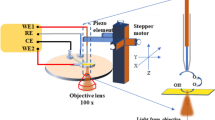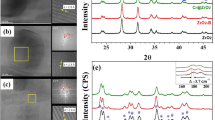Abstract
Solar-driven photocatalytic reactions offer a promising route to clean and sustainable energy, and the spatial separation of photogenerated charges on the photocatalyst surface is the key to determining photocatalytic efficiency. However, probing the charge-separation properties of photocatalysts is a formidable challenge because of the spatially heterogeneous microstructures, complicated charge-separation mechanisms and lack of sensitivity for detecting the low density of separated photogenerated charges. Recently, we developed surface photovoltage microscopy (SPVM) with high spatial and energy resolution that enables the direct mapping of surface-charge distributions and quantitative assessment of the charge-separation properties of photocatalysts at the nanoscale, potentially providing unprecedented insights into photocatalytic charge-separation processes. Here, this protocol presents detailed procedures that enable researchers to construct the SPVM instruments by integrating Kelvin probe force microscopy with an illumination system and the modulated surface photovoltage (SPV) approach. It then describes in detail how to perform SPVM measurements on actual photocatalyst particles, including sample preparation, tuning of the microscope, adjustment of the illuminated light path, acquisition of SPVM images and measurements of spatially resolved modulated SPV signals. Moreover, the protocol also includes sophisticated data analysis that can guide non-experts in understanding the microscopic charge-separation mechanisms. The measurements are ordinarily performed on photocatalysts with a conducting substrate in gases or vacuum and can be completed in 15 h.
Key points
-
Probing the charge-separation properties of photocatalysts is a formidable challenge because of the spatially heterogeneous microstructures, complicated charge-separation mechanisms and low density of separated photogenerated charges.
-
Surface photovoltage microscopy as described in this protocol has sufficiently high spatial and energy resolution to enable direct mapping of surface-charge distributions and quantitative assessment of the charge-separation properties of individual photocatalyst particles.
This is a preview of subscription content, access via your institution
Access options
Access Nature and 54 other Nature Portfolio journals
Get Nature+, our best-value online-access subscription
$29.99 / 30 days
cancel any time
Subscribe to this journal
Receive 12 print issues and online access
$259.00 per year
only $21.58 per issue
Buy this article
- Purchase on Springer Link
- Instant access to full article PDF
Prices may be subject to local taxes which are calculated during checkout












Similar content being viewed by others
Data availability
All data generated or analyzed during this study are available at https://figshare.com/ (https://doi.org/10.6084/m9.figshare.24466933.v1) or from the corresponding author upon reasonable request.
References
Tachibana, Y., Vayssieres, L. & Durrant, J. R. Artificial photosynthesis for solar water-splitting. Nat. Photonics 6, 511–518 (2012).
Lewis, N. S. Research opportunities to advance solar energy utilization. Science 351, aad1920 (2016).
Wang, Q. et al. Scalable water splitting on particulate photocatalyst sheets with a solar-to-hydrogen energy conversion efficiency exceeding 1%. Nat. Mater. 15, 611–615 (2016).
Chen, S., Takata, T. & Domen, K. Particulate photocatalysts for overall water splitting. Nat. Rev. Mater. 2, 17050 (2017).
Hisatomi, T. & Domen, K. Reaction systems for solar hydrogen production via water splitting with particulate semiconductor photocatalysts. Nat. Catal. 2, 387–399 (2019).
Nishiyama, H. et al. Photocatalytic solar hydrogen production from water on a 100-m2 scale. Nature 598, 304–307 (2021).
Zhou, P. et al. Solar-to-hydrogen efficiency of more than 9% in photocatalytic water splitting. Nature 613, 66–70 (2023).
Fujishima, A. & Honda, K. Electrochemical photolysis of water at a semiconductor electrode. Nature 238, 37–38 (1972).
Baxter, J. B., Richter, C. & Schmuttenmaer, C. A. Ultrafast carrier dynamics in nanostructures for solar fuels. Annu. Rev. Phys. Chem. 65, 423–447 (2014).
Corby, S., Rao, R. R., Steier, L. & Durrant, J. R. The kinetics of metal oxide photoanodes from charge generation to catalysis. Nat. Rev. Mater. 6, 1136–1155 (2021).
Chen, R., Fan, F. & Li, C. Unraveling charge-separation mechanisms in photocatalyst particles by spatially resolved surface photovoltage techniques. Angew. Chem. Int. Ed. Engl. 61, e202117567 (2022).
Wang, D., Sheng, T., Chen, J., Wang, H.-F. & Hu, P. Identifying the key obstacle in photocatalytic oxygen evolution on rutile TiO2. Nat. Catal. 1, 291–299 (2018).
Chen, R., Fan, F., Dittrich, T. & Li, C. Imaging photogenerated charge carriers on surfaces and interfaces of photocatalysts with surface photovoltage microscopy. Chem. Soc. Rev. 47, 8238–8262 (2018).
Zhu, J. et al. Direct imaging of highly anisotropic photogenerated charge separations on different facets of a single BiVO4 photocatalyst. Angew. Chem. Int. Ed. Engl. 54, 9111–9114 (2015).
Zhu, J. et al. Visualizing the nano cocatalyst aligned electric fields on single photocatalyst particles. Nano Lett. 17, 6735–6741 (2017).
Chen, R. et al. Charge separation via asymmetric illumination in photocatalytic Cu2O particles. Nat. Energy 3, 655–663 (2018).
Chen, R. et al. Spatiotemporal imaging of charge transfer in photocatalyst particles. Nature 610, 296–301 (2022).
Li, R. et al. Spatial separation of photogenerated electrons and holes among {010} and {110} crystal facets of BiVO4. Nat. Commun. 4, 1432 (2013).
Wang, S., Liu, G. & Wang, L. Crystal facet engineering of photoelectrodes for photoelectrochemical water splitting. Chem. Rev. 119, 5192–5247 (2019).
Takata, T. et al. Photocatalytic water splitting with a quantum efficiency of almost unity. Nature 581, 411–414 (2020).
Wang, X. et al. Trap states and carrier dynamics of TiO2 studied by photoluminescence spectroscopy under weak excitation condition. Phys. Chem. Chem. Phys. 12, 7083–7090 (2010).
Mesa, C. A. et al. Multihole water oxidation catalysis on haematite photoanodes revealed by operando spectroelectrochemistry and DFT. Nat. Chem. 12, 82–89 (2020).
Yang, Y. et al. Semiconductor interfacial carrier dynamics via photoinduced electric fields. Science 350, 1061–1065 (2015).
Carneiro, L. M. et al. Excitation-wavelength-dependent small polaron trapping of photoexcited carriers in alpha-Fe2O3. Nat. Mater. 16, 819–825 (2017).
Grave, D. A. et al. Extraction of mobile charge carrier photogeneration yield spectrum of ultrathin-film metal oxide photoanodes for solar water splitting. Nat. Mater. 20, 833–840 (2021).
Wang, J., Zhao, J. & Osterloh, F. E. Photochemical charge transfer observed in nanoscale hydrogen evolving photocatalysts using surface photovoltage spectroscopy. Energy Environ. Sci. 8, 2970–2976 (2015).
Mora-Seró, I., Dittrich, T., Garcia-Belmonte, G. & Bisquert, J. Determination of spatial charge separation of diffusing electrons by transient photovoltage measurements. J. Appl. Phys. 100, 103705 (2006).
Gross, D. et al. Charge separation in type II tunneling multilayered structures of CdTe and CdSe nanocrystals directly proven by surface photovoltage spectroscopy. J. Am. Chem. Soc. 132, 5981–5983 (2010).
Sambur, J. B. et al. Sub-particle reaction and photocurrent mapping to optimize catalyst-modified photoanodes. Nature 530, 77–80 (2016).
Hesari, M., Mao, X. & Chen, P. Charge carrier activity on single-particle photo(electro)catalysts: toward function in solar energy conversion. J. Am. Chem. Soc. 140, 6729–6740 (2018).
Mao, X. & Chen, P. Inter-facet junction effects on particulate photoelectrodes. Nat. Mater. 21, 331–337 (2022).
Warren, S. C. et al. Identifying champion nanostructures for solar water-splitting. Nat. Mater. 12, 842–849 (2013).
Gerber, C. & Lang, H. P. How the doors to the nanoworld were opened. Nat. Nanotechnol. 1, 3–5 (2006).
Bonnell, D. A. et al. Imaging physical phenomena with local probes: from electrons to photons. Rev. Mod. Phys. 84, 1343–1381 (2012).
Melitz, W., Shen, J., Kummel, A. C. & Lee, S. Kelvin probe force microscopy and its application. Surf. Sci. Rep. 66, 1–27 (2011).
Nanayakkara, S. U. et al. Built-in potential and charge distribution within single heterostructured nanorods measured by scanning Kelvin probe microscopy. Nano Lett. 13, 1278–1284 (2013).
Bergmann, V. W. et al. Real-space observation of unbalanced charge distribution inside a perovskite-sensitized solar cell. Nat. Commun. 5, 5001 (2014).
Chen, Q. et al. Quantitative operando visualization of the energy band depth profile in solar cells. Nat. Commun. 6, 7745 (2015).
Jiang, C. S. et al. Carrier separation and transport in perovskite solar cells studied by nanometre-scale profiling of electrical potential. Nat. Commun. 6, 8397 (2015).
He, T. et al. Site-specific chemical doping reveals electron atmospheres at the surfaces of organic semiconductor crystals. Nat. Mater. 20, 1532–1538 (2021).
Ida, S., Takashiba, A., Koga, S., Hagiwara, H. & Ishihara, T. Potential gradient and photocatalytic activity of an ultrathin p-n junction surface prepared with two-dimensional semiconducting nanocrystals. J. Am. Chem. Soc. 136, 1872–1878 (2014).
Kronik, L. & Shapira, Y. Surface photovoltage phenomena: theory, experiment, and applications. Surf. Sci. Rep. 37, 1–206 (1999).
Liscio, A. et al. Photovoltaic charge generation visualized at the nanoscale: a proof of principle. J. Am. Chem. Soc. 130, 780–781 (2008).
Spadafora, E. J., Demadrille, R., Ratier, B. & Grevin, B. Imaging the carrier photogeneration in nanoscale phase segregated organic heterojunctions by Kelvin probe force microscopy. Nano Lett. 10, 3337–3342 (2010).
Luria, J. L. et al. Spectroscopic imaging of photopotentials and photoinduced potential fluctuations in a bulk heterojunction solar cell film. ACS Nano 6, 9392–9401 (2012).
Shao, G. Z., Glaz, M. S., Ma, F., Ju, H. X. & Ginger, D. S. Intensity-modulated scanning Kelvin probe microscopy for probing recombination in organic photovoltaics. ACS Nano 8, 10799–10807 (2014).
Tennyson, E. M. et al. Nanoimaging of open-circuit voltage in photovoltaic devices. Adv. Energy Mater. 5, 1501142 (2015).
Garrett, J. L. et al. Real-time nanoscale open-circuit voltage dynamics of perovskite solar cells. Nano Lett. 17, 2554–2560 (2017).
Chen, R. et al. Giant defect-induced effects on nanoscale charge separation in semiconductor photocatalysts. Nano Lett. 19, 426–432 (2019).
Linic, S., Aslam, U., Boerigter, C. & Morabito, M. Photochemical transformations on plasmonic metal nanoparticles. Nat. Mater. 14, 567–576 (2015).
Aslam, U., Rao, V. G., Chavez, S. & Linic, S. Catalytic conversion of solar to chemical energy on plasmonic metal nanostructures. Nat. Catal. 1, 656–665 (2018).
Wang, S. et al. Positioning the water oxidation reaction sites in plasmonic photocatalysts. J. Am. Chem. Soc. 139, 11771–11778 (2017).
Gao, Y. et al. Probing of coupling effect induced plasmonic charge accumulation for water oxidation. Natl Sci. Rev. 8, nwaa151 (2021).
Wang, X. et al. In situ construction of a Cs2SnI6 perovskite nanocrystal/SnS2 nanosheet heterojunction with boosted interfacial charge transfer. J. Am. Chem. Soc. 141, 13434–13441 (2019).
Xin, Z. et al. Rational design of dot-on-rod nano-heterostructure for photocatalytic CO2 reduction: pivotal role of hole transfer and utilization. Adv. Mater. 34, e2106662 (2022).
Zhang, B. et al. Facet-oriented assembly of Mo:BiVO4 and Rh:SrTiO3 particles: integration of p–n conjugated photo-electrochemical system in a particle applied to photocatalytic overall water splitting. ACS Catal. 12, 2415–2425 (2022).
Ben, H. et al. Diffusion‐controlled Z‐scheme‐steered charge separation across PDI/BiOI heterointerface for ultraviolet, visible, and infrared light‐driven photocatalysis. Adv. Funct. Mater. 31, 2102315 (2021).
Liu, Y. et al. Phase-enabled metal-organic framework homojunction for highly selective CO2 photoreduction. Nat. Commun. 12, 1231 (2021).
Zhang, S. et al. Boosted photoreforming of plastic waste via defect-rich NiPS(3) nanosheets. J. Am. Chem. Soc. 145, 6410–6419 (2023).
Tachikawa, T., Yamashita, S. & Majima, T. Evidence for crystal-face-dependent TiO2 photocatalysis from single-molecule imaging and kinetic analysis. J. Am. Chem. Soc. 133, 7197–7204 (2011).
Mao, X., Liu, C., Hesari, M., Zou, N. & Chen, P. Super-resolution imaging of non-fluorescent reactions via competition. Nat. Chem. 11, 687–694 (2019).
Tachikawa, T., Ochi, T. & Kobori, Y. Crystal-face-dependent charge dynamics on a BiVO4 photocatalyst revealed by single-particle spectroelectrochemistry. ACS Catal. 6, 2250–2256 (2016).
Lee, J. K., Wu, S., Lim, P. C. & Zhang, Z. Spectrally resolved single particle photoluminescence microscopy reveals heterogeneous photocorrosion activity of cuprous oxide microcrystals. Nano Lett. 22, 4654–4660 (2022).
Man, M. K. et al. Imaging the motion of electrons across semiconductor heterojunctions. Nat. Nanotechnol. 12, 36–40 (2017).
Doherty, T. A. S. et al. Performance-limiting nanoscale trap clusters at grain junctions in halide perovskites. Nature 580, 360–366 (2020).
Najafi, E., Scarborough, T. D., Tang, J. & Zewail, A. Four-dimensional imaging of carrier interface dynamics in p-n junctions. Science 347, 164–167 (2015).
Liao, B., Najafi, E., Li, H., Minnich, A. J. & Zewail, A. H. Photo-excited hot carrier dynamics in hydrogenated amorphous silicon imaged by 4D electron microscopy. Nat. Nanotechnol. 12, 871–876 (2017).
Terada, Y., Yoshida, S., Takeuchi, O. & Shigekawa, H. Real-space imaging of transient carrier dynamics by nanoscale pump–probe microscopy. Nat. Photonics 4, 869–874 (2010).
Guo, C. et al. Probing nonequilibrium dynamics of photoexcited polarons on a metal-oxide surface with atomic precision. Phys. Rev. Lett. 124, 206801 (2020).
Coffey, D. C. & Ginger, D. S. Time-resolved electrostatic force microscopy of polymer solar cells. Nat. Mater. 5, 735–740 (2006).
Collins, L. et al. Breaking the time barrier in Kelvin probe force microscopy: fast free force reconstruction using the G-mode platform. ACS Nano 11, 8717–8729 (2017).
Giridharagopal, R. et al. Submicrosecond time resolution atomic force microscopy for probing nanoscale dynamics. Nano Lett. 12, 893–898 (2012).
Umeda, K.-I. et al. Practical aspects of Kelvin-probe force microscopy at solid/liquid interfaces in various liquid media. J. Appl. Phys. 116, 134307 (2014).
Collins, L. et al. Probing charge screening dynamics and electrochemical processes at the solid-liquid interface with electrochemical force microscopy. Nat. Commun. 5, 3871 (2014).
Hackl, T., Schitter, G. & Mesquida, P. AC Kelvin probe force microscopy enables charge mapping in water. ACS Nano 16, 17982–17990 (2022).
Collins, L., Kilpatrick, J. I., Kalinin, S. V. & Rodriguez, B. J. Towards nanoscale electrical measurements in liquid by advanced KPFM techniques: a review. Rep. Prog. Phys. 81, 086101 (2018).
Nellist, M. R. et al. Potential-sensing electrochemical atomic force microscopy for in operando analysis of water-splitting catalysts and interfaces. Nat. Energy 3, 46–52 (2017).
Laskowski, F. A. L. et al. Nanoscale semiconductor/catalyst interfaces in photoelectrochemistry. Nat. Mater. 19, 69–76 (2020).
Chen, R. et al. Linking the photoinduced surface potential difference to interfacial charge transfer in photoelectrocatalytic water oxidation. J. Am. Chem. Soc. 145, 4667–4674 (2023).
Barbet, S. et al. Cross-talk artefacts in Kelvin probe force microscopy imaging: a comprehensive study. J. Appl. Phys. 115, 144313 (2014).
Ziegler, D. & Stemmer, A. Force gradient sensitive detection in lift-mode Kelvin probe force microscopy. Nanotechnology 22, 075501 (2011).
Enevoldsen, G. H., Glatzel, T., Christensen, M. C., Lauritsen, J. V. & Besenbacher, F. Atomic scale Kelvin probe force microscopy studies of the surface potential variations on the TiO2 (110) surface. Phys. Rev. Lett. 100, 236104 (2008).
Fengler, S. & Dittrich, T. Algorithm for random walk simulation of modulated surface photovoltage signals in nanostructured systems with localized states. J. Phys. Chem. C. 120, 17777–17783 (2016).
Ivanov, T., Donchev, V., Germanova, K. & Kirilov, K. A vector model for analysing the surface photovoltage amplitude and phase spectra applied to complicated nanostructures. J. Phys. D. Appl. Phys. 42, 135302 (2009).
Minegishi, T., Nishimura, N., Kubota, J. & Domen, K. Photoelectrochemical properties of LaTiO2N electrodes prepared by particle transfer for sunlight-driven water splitting. Chem. Sci. 4, 1120 (2013).
Liu, R. R. et al. Facet dependent SEI formation on the LiNi0.5Mn1.5O4 cathode identified by in situ single particle atomic force microscopy. Chem. Commun. 50, 15756–15759 (2014).
Siegfried, M. J. & Choi, K. S. Electrochemical crystallization of cuprous oxide with systematic shape evolution. Adv. Mater. 16, 1743–1746 (2004).
Cui, A. et al. Probing electromechanical behaviors by datacube piezoresponse force microscopy in ambient and aqueous environments. Nanotechnology 30, 235701 (2019).
Arrighi, A., Ullberg, N., Derycke, V. & Grevin, B. A simple KPFM-based approach for electrostatic-free topographic measurements: the case of MoS2 on SiO2. Nanotechnology 34, 215705 (2023).
Melo, M. A. Jr. et al. Surface photovoltage measurements on a particle tandem photocatalyst for overall water splitting. Nano Lett. 18, 805–810 (2018).
Acknowledgements
This work was financially supported by the National Natural Science Foundation of China (22372159, 22102173, 22088102 and 22325205), the Young Elite Scientist Sponsorship Program by CAST (YESS20220177), the National Program on Key Basic Research Project (2021YFA1500600 and 2021YFA1502300), CAS Projects for Young Scientists in Basic Research (YSBR-004) and Interdisciplinary Innovation Team (JCTD-2018-10) and the Dalian Institute of Chemical Physics Innovation Foundation (DICPSZ201801).
Author information
Authors and Affiliations
Contributions
C.L. conceived and proposed the project. R.C. and F.F. carried out the project. R.C. conceived the protocol, performed the experiments, analyzed the data and wrote and edited the manuscript. C.N. assisted in organizing procedures, J.Z. assisted in experimental setup and F.F. and C.L. revised the manuscript.
Corresponding authors
Ethics declarations
Competing interests
The authors declare no competing interests.
Peer review
Peer review information
Nature Protocols thanks Hongqi Sun and the other, anonymous, reviewer(s) for their contribution to the peer review of this work.
Additional information
Publisher’s note Springer Nature remains neutral with regard to jurisdictional claims in published maps and institutional affiliations.
Related links
Key references using this protocol
Chen, R. et al. Chem. Soc. Rev. 47, 8238–8262 (2018): https://doi.org/10.1039/C8CS00320C
Chen, R. et al. Nat. Energy 3, 655–663 (2018): https://doi.org/10.1038/s41560-018-0194-0
Chen, R. et al. Nature 610, 296–301 (2022): https://doi.org/10.1038/s41586-022-05183-1
Chen, R. et al. Nano Lett. 19, 426–432 (2019): https://doi.org/10.1021/acs.nanolett.8b04245
Extended data
Supplementary information
Rights and permissions
Springer Nature or its licensor (e.g. a society or other partner) holds exclusive rights to this article under a publishing agreement with the author(s) or other rightsholder(s); author self-archiving of the accepted manuscript version of this article is solely governed by the terms of such publishing agreement and applicable law.
About this article
Cite this article
Chen, R., Ni, C., Zhu, J. et al. Surface photovoltage microscopy for mapping charge separation on photocatalyst particles. Nat Protoc (2024). https://doi.org/10.1038/s41596-024-00992-2
Received:
Accepted:
Published:
DOI: https://doi.org/10.1038/s41596-024-00992-2
Comments
By submitting a comment you agree to abide by our Terms and Community Guidelines. If you find something abusive or that does not comply with our terms or guidelines please flag it as inappropriate.



